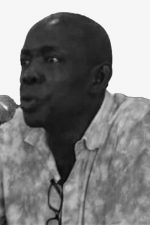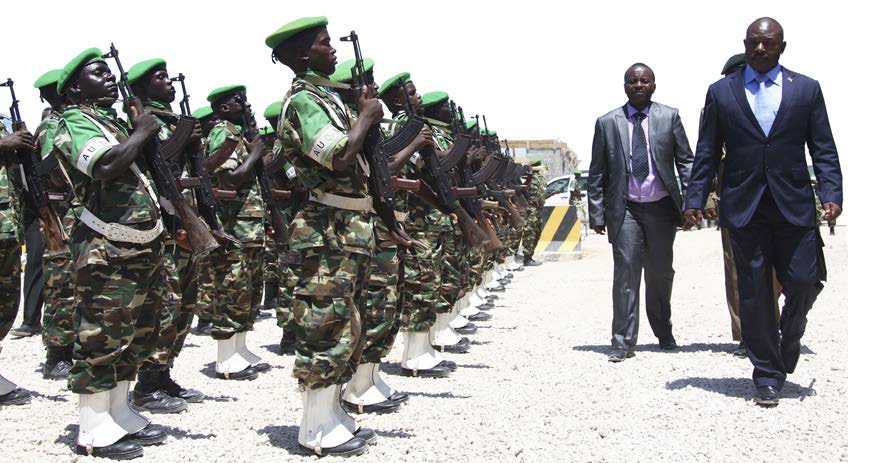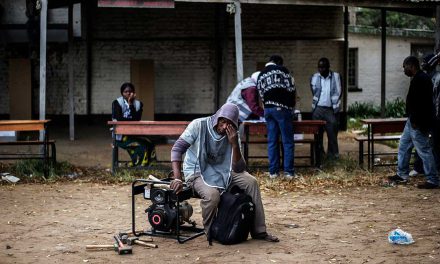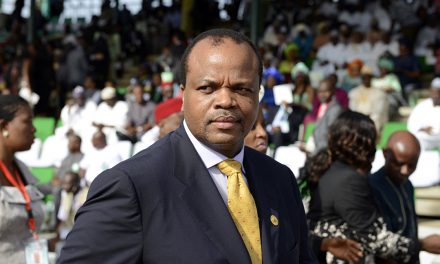Senegal: a conflict in the public space
Journalists have an important role to play in documenting and researching the causes of Senegal’s Casamance conflict, helping to bring political opponents together
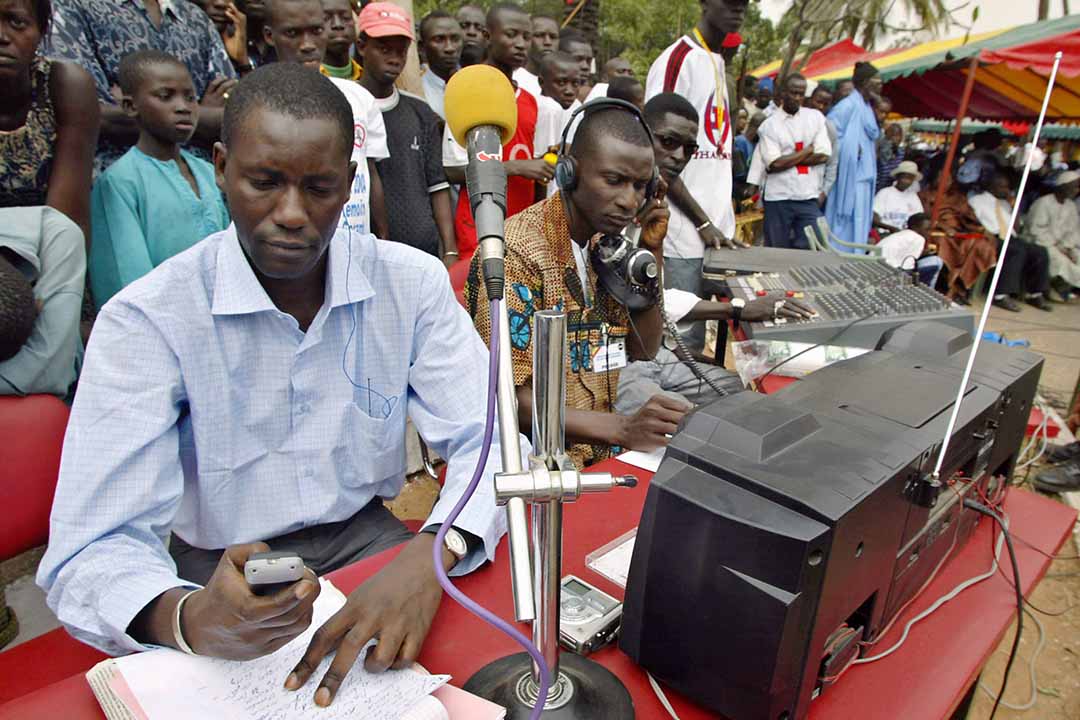
Journalist Idrahima Gassama (left) of radio SudFM and his team transmit live on the day of the signing of a peace pact between Senegal’s government and separatist rebels to end decades of conflict in the southern Casamance region, 2004 Photo: SEYLLOU DIALLO / AFP
The democratic culture Senegal is so proud of dates from the 19th century when France, the colonising power, extended the scope of the Declaration of the Rights of Man and of the Citizen (1789) to the colonies and passed a law (1881) establishing freedom of the press. Multiparty politics and pluralism of the press were established, in particular from 1886 with the circulation of the newspapers Réveil du Sénégal (Awakening of Senegal) and Le Petit Sénégalais (The Little Senegalese). In post-colonial times, state monopoly of the media in the name of national construction and development became a widespread practice across the continent.
This was a period characterised by chronic institutional instability, a succession of coups and underdevelopment. In Senegal, banned opposition parties fought long and hard for the restoration of democracy, supported by an underground press. The 1980s were marked by the reinstatement of a full multiparty system under the government of Abdou Diouf in 1981 and the emergence at the end of the decade of a new independent press, mostly run by journalists trained at the Study Center Science et Technology de L’information (CESTI).
During this time, a “quasi-institutional backbone” of the Senegalese media space was created, which revolved around publications such as the Sud quotidien (South-daily Life), Walfadjri, the Cafard Libéré (the Liberated Cockroach), Témoin (Witness) and, later, Nouvel Horizon (New Horizon), among others. The 1990s saw the emergence of a dynamic, professional private press, equidistant from power and opposition. It earned the title of “independent press” by reflecting the daily experience of the country’s population and their socio-economic difficulties, as well as reflecting opposition views, which were censored by the state.
The 1990s marked a turning point in the definition of new challenges facing Senegalese democracy. Disputes linked to the presidential elections of 1988 and 1993, and the ensuing violent riots, established that there was a need to establish reliable and credible institutions capable of ensuring the transparency of the electoral process and of preventing post-electoral conflicts. The National Assembly adopted a consensus media code in 1996, as well as an electoral register viewed as reliable by the various political actors.
The High Council for Radio-Television (HCRT), which later became the National Audiovisual Regulation Council (CNRA), was established to ensure equal access for political parties to public audiovisual media, respect for moral values and the diversity of the nation’s socio-cultural components in the programming of the shows.
Today, Senegal has more than 20 daily newspapers and a few popular weeklies, which have dominated the weekly landscape for more than two decades. In the audiovisual sector, there are about 10 private television channels, 20 private radio stations and around 30 community radio stations, alongside the public service of Senegalese Radio-Television. It is against this backdrop that we examine the interaction between media, democracy, peace and security in order to assess the impact of journalists’ professional practices on the stability of the Senegalese state.
A rebellion has been raging in the Casamance region since 1982, led by the separatist Mouvement des Forces Démocratiques de la Casamance (MFDC). Casamance is geographically separated from a large part of the rest of Senegal by Gambia, and sociologically by ethnic and religious differences. Before the conflict began, public debate around the south region was shaped by the perceived “contempt” of the predominantly Islamic north. From the capital, Dakar, to the groundnut basin, the north is dominated by the Wolof ethnic group, whose language, practices and “Islamo-Wolof” values were eventually embodied in the culture and functioning of the state and its institutions.
The Wolof culture attained the status of reference culture, creating frustration and sometimes violent reactions from other sections of the nation. Wolof-language media, and the audiovisual media in particular, have helped to legitimise Wolof hegemony by allowing only a small share of programming time to other languages and cultures.
State media trivialised the Casamance conflict as a simple jacquerie (popular uprising) or as the rowdiness of a few disaffected people without popular legitimacy. This monolithic treatment of the conflict fostered a feeling of exteriority and created a distance from public concerns. The crisis in the south was perceived as an epiphenomenon, occurring in a forlorn corner of Senegal. In addition, journalistic self-censorship helped to mask the political stakes and the scope of the crisis. However, the dominance of this view was challenged from 1994, with the liberalisation of the audiovisual space.
New media titles and several private stations emerged, followed by the country’s first multimedia groups, which aimed to penetrate the opinion segment of the media market. Sud-FM was the first Senegalese radio station to break the monopoly of Radio Sénégal. The independent press began to give visibility to the Caramance independence movement in the public sphere. The movement was organised around Father Augustin Diamacoune, a “charismatic leader”.
The state had been accused of being indifferent to the claims of a marginalised and culturally despised population and of refusing to talk with independence rebels. Now, with more coverage of the conflict in the new independent media, the state took a more proactive attitude towards the rebellion. It recognised its political dimension and agreed to start a negotiation process with the MFDC from 1991, which led to the Cacheu Agreements in Guinea-Bissau. Meanwhile, media coverage of MFDC attacks on state representatives and administrative buildings reinforced its stature as a movement, while highlighting the weakness of the state.
The demands of the independence movement moved closer to the centre of public discourse. Greater freedom of information offered a space for expression. Separatist movements use acts of terror to establish “symbiotic” relationships with the media, and so to broaden their audiences. Such events are tailor-made for journalists, who find “media events” in images of disaster, and use these to arouse curiosity and emotion in their audiences.
Some, indeed, have described this as an “evil pact” between media and terrorism. At any rate, the independent media had discovered a power which, if not autonomous, became the object of instrumentalisation. Both sides integrated media into their strategies. During the Casamance conflict, the socialist regime and that of the “Alternation” era (of democratic regime change) adopted different approaches to communication and the media.
Between 1982 and 2000, the socialist strategy alternated between silence and manipulation. In the latter mode, a new military communications unit was created, DIRPA, to legitimise the army. Initially it did so by organising seminars aimed at raising awareness of the concept of “sensitive information”. Journalists were also given guided tours of Casamance, which prevented them from independent reporting. Sometimes this approach was successful, helping to rehabilitate the image of the army. Senegal’s military intervention in Guinea-Bissau in May 1998, during an army mutiny led by General Ansoumana Mané against the regime of President Bernardo Nino Vieira, was justified, through the press, by the legal concerns regarding mutual defence agreements which existed between Dakar and Bissau.
The official line was that the intervention was aimed at restoring constitutional order in Guinea-Bissau. The media helped by ignoring the fact that the Guinea- Bissau government’s position had implications for the Casamance rebellion. The country bordered on Senegal and had long been a back-up base for fighters of the rebellion. In the same way, the years between 1995 and 1997 were marked by deadly assaults by the MFDC, resulting in the deaths of Senegalese troops, which animated nationalist sentiment. Most journalists adopted a warmongering tone, castigating the state’s “sluggishness” and calling for increased military commitment and an “end” to the rebellion.
The military’s version of events was widely publicised and led people to believe that the end of the conflict was near. But, as we have seen, in the early 1990s, media reports about the conflict were carried by new independent media. In addition, press releases and reports by human rights organisations such as Amnesty International and the African Human Rights Meeting (RADDHO) exposed the abuses committed by the belligerents, particularly the armed forces, damaging the image of the state.
The publicity given to the rebels’ attacks on public buildings and on state representatives (prefect, sub-prefects, teachers) caused terror in the population and cast doubt on the public authorities’ ability to protect people and property. Most observers will agree that from 2000, there were increasing clashes between government and the press regarding the Casamance conflict. The intimidation of journalists, arrests, suspensions and bans on broadcasting were more frequent. Paradoxically, this came at a time when the word “peace” was on everyone’s lips. The slightest skirmish or the slightest dissident opinion relayed by the media awakened memories an old electoral promise to resolve the conflict in Casamance within 100 days.
On 21 August, 2000, more than a hundred days after the election and change of government, Le Matin, a newspaper, ran a front-page article: ‘The rebels move freely in Ziguinchor’. The editor and his journalist were summoned to the Criminal Investigation Division (DIC) to account for their “dissemination of false news, attack on the morals of the army and the country’s populations and attack on the national security of the state”.
On 25 August, 2000, the president issued a press release stating that only the head of state, as head of the armed forces, could judge the advisability of defence and protection measures involving the army. The press release also commented that journalists had undermined the army through sensationalist reporting. Mamadou Talla, editor of Le Populaire, and a journalist were also summoned to the DIC on 12 December, 2000 for publishing articles that traced the origins of the Casamance conflict to ethnic rivalries.
At around that time, a radio interview with rebel leader Salif Sadio on Sud-FM was immediately banned and staff of the station arrested under an “emergency measure” taken by the minister of the interior. It can be argued that these clashes between the Senegalese state and the media resulted in less coverage of Casamance. The media have failed to cover it systematically since then. Causes have been caricatured and prejudices reinforced. The rebellion has been projected as someone else’s problem.
In addition, there was little or no academic research on the conflict until the 1990s. The beginning of the conflict and its root causes were poorly documented, and even essentially factual articles offered little prospect for contextualisation. Moreover, the conflict has endured for so long that reporters deeply involved in reporting the Casamance conflict have been replaced by a new generation for whom the conflict is much less important. Momar Coumba Diop and Mamadou Diouf, who edited a number of research works on the conflict, were pioneers in this area, but received very little media attention.
Their publications, which range from the Trajectoire d’un Etat (published in English as Senegal, Essays in Statecraft, 1993) to Senegal under Abdou Diouf, 1992, and Le Sénégal contemporain (Contemporary Senegal, 2002) and Sénégal: Les ethnies et la nation (Senegal: ethnic groups and the nation, 1998) by Makhtar Diouf, were followed by other academic research on Casamance. But while the conflict did become a centre of interest in academia and research, no bridges were built between this approach and that of the media.
“Capture and decryption” refers to the professional aptitude essential to the calling of the journalist, whose aim is to give readers access to the facts and discourses that structure the life of the nation. The media give the national discourse meaning while at the same time challenging it. This conception of journalism depends on training practitioners to participate in public life and to serve as links beween players in the public sphere.
This kind of journalism, sometimes described as complex journalism, is more necessary than ever in a context of conflict like the one of Casamance – which in itself is an example of complexity, with its multifaceted causes, diversity of actors, and visible or invisible interests. For example, the rebels present their region as “beautiful and rebellious”, but this narrative blurs other causes of the conflict, including economic marginalisation and the land issue. During the 1970s, the government expropriated land there on a large scale, which led many to join the fighters in the maquis.
Geopolitical issues at the sub-regional level, such as the relationship between Gambia and Guinea-Bissau, are also at stake. Then again, the underground character of the rebellion movements can make them difficult to identify. This invisibility can mean that media houses and journalists ignore the Casamance issue, or take shortcuts. Currently, they are mostly content with reports on robberies and other acts of violence: these are “news stories”. When it is discussed, Casamance is presented as a conflict of identity. However, the independent media seldom simply adopt the official point of view of “non-negotiability of independence”.
After decades of conflict, there is still little sign of any political solution to the Casamance question. The state sometimes adopts repressive measures against the press, or censors particular works. Mostly the subject is surrounded by deep silence. Nevertheless, there are some things which the media can do to contribute to real peace. The causes of the Casamance conflict need to be systematically researched and documented.
Journalism is a form of mediation, and equidistant information processing helps to bring political opponents together. An important part of this involves ensuring that marginalised voices are heard This approach opens the public space to all statements, even those which shock or collide. Out of this friction the truth arises, and the beat of peaceful hearts.
Moustapha Gueye is a research associate with the Gorée Institute, Senegal. He holds a doctorate in information and communication sciences and is a researcher and senior lecturer at the Centre d’études des Sciences et Techniques de l’information (CESTI) at Cheikh Anta Diop University in Dakar. His research interests include media, conflict, peace and democracy.


